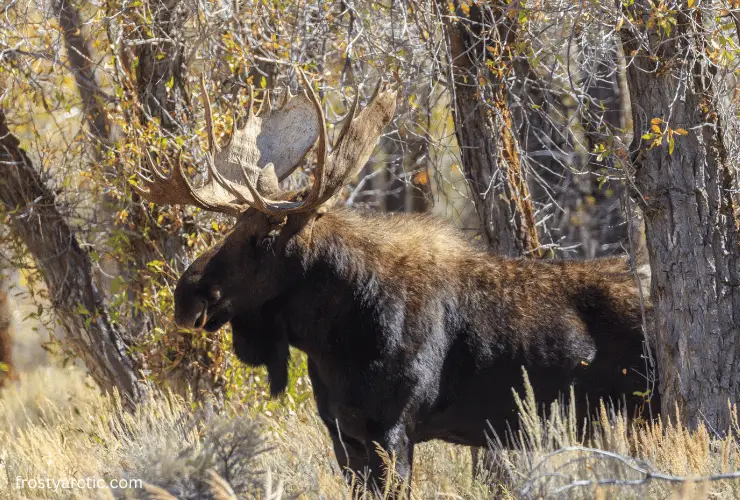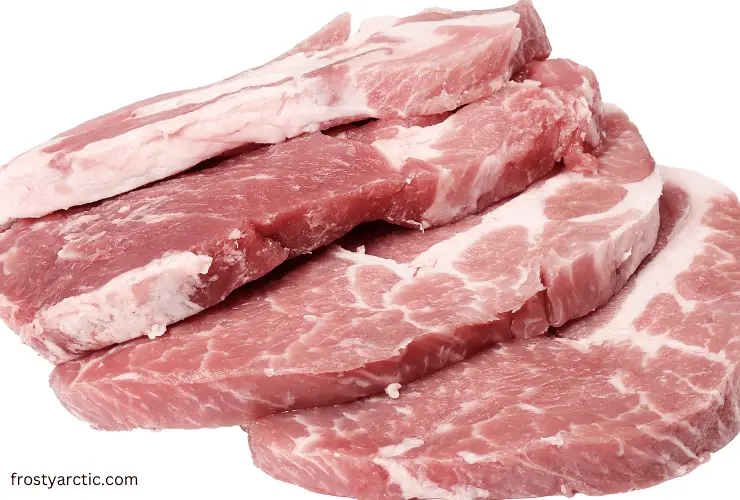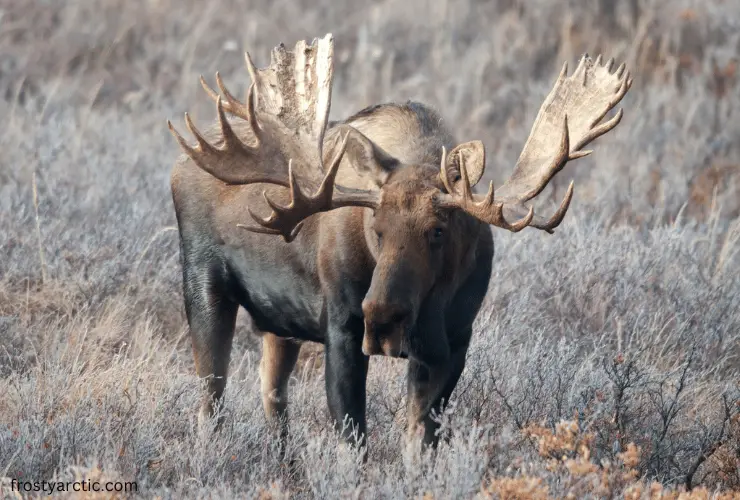Yes! From the hinterlands of Alaska to the parks of Canada, moose are one of the most majestic and beloved species on the continent. It’s hard not to admire their bulky bodies, gigantic antlers, and graceful movements. Also, consuming moose is recognized as safe and healthiest available.
But have you ever considered eating one? While it might seem like an outlandish idea at first glance, as surprising as it may be, there are actually people out there that enjoy consuming this majestic animal’s meat.
Can You Eat Moose? Nutrients Found in Moose
Moose are the largest member of the deer family. They can be found in Alaska, Canada, Scandinavia, and Russia.
Moose are herbivores and eat leaves, twigs, shrubs, and aquatic plants. Moose are generally solitary animals but can be found in small herds during mating season or when grazing. Bulls (male moose) can weigh up to 1,800 pounds and stand 7 feet tall at the shoulder.
Did you know Cows (female moose) are slightly smaller and weigh up to 1,600 pounds? Moose are generally shy animals but can be dangerous if they feel threatened.
Nutrients Found in Moose
| Nutrients Percentage/serving | (Raw) Kidney (90 g) | (Raw) Liver (90 g) | Cooked Bone Marrow | Dried meat | Roasted meat | Blood (raw) |
| An excellent food source means it supplies 25% or more of a nutrient per day | Protein Iron | Protein Iron Vitamin A Folate B Vitamins | Protein Iron | Protein, Iron B Vitamins (B12 & Niacin) | Protein Iron | |
| A good source supplies 15 – 24% of a nutrient per day | iron | |||||
| A fair source supplies 5 – 14% of a nutrient per day |
Tips
- Reference Serving Sizes are from Canada’s Food Guide (dried = 35g, cooked = 75g, raw = 90g).
- The Recommended Dietary Allowance (RDA) amounts are based on the needs of a 14 – 18-year-old girl.
- Excellent, good and fair sources of nutrients have been standardized for any type of food source.
A Study Report About Moose Nutritional Food Fact
Moose are some of the largest members of the deer family and have a diet composed of aquatic plant life, leaves, tree bark, small invertebrates, and sometimes small amphibians.

A recent study report focused on the nutritional composition of what moose typically eat to get an accurate understanding of the animals’ daily requirement for various nutrients like proteins, fats, carbohydrates and minerals.
The data from this report helps us get a more comprehensive understanding of how much food sources moose need to remain healthy. It also provides insight into how their diets may vary depending on the season or geographic location.
By exploring the nutrition facts found in a typical diet for the moose, we can better understand how we should be supporting their conservation with proper environmental protection and improved land use management.~[source]
What Does Moose Meat Taste Like?
If you have never eaten moose meat before, you may be surprised to learn that it is incredibly satisfying. It has a sweet yet subtly gamey flavor that is different from any other wild game or livestock type.
The texture of moose meat tends to range from mild and tenderloin cuts to more strongly flavored ones. Many people describe the taste as similar to beef but a bit richer and sweeter.
Moose meat is also rich in omega-3 fatty acids, making it a nutritious and delicious option for any meal. So, if you’re looking for something unusual to add to your plate, look no further than moose meat – one bite could win you over!
What is the Meat of Moose Called?
When discussing the meat of the moose, it’s important to know that moose aren’t found everywhere.
In fact, these animals are native to places such as Canada, Alaska, Scandinavia and Siberia. Moose meat is quite savory, full of flavor and low in fat. It comes from both female and male moose and is referred to by a few names such as “moose steaks”, “venison,” or simply “moose meat”.
Interestingly enough, if you have tasted Elk meat, then you have had Moose meat too, since they are closely related!
The main difference is that Elk taste a bit sweeter due to their diet, but the texture is usually very similar. If you ever get your hands on some Moose meat, then be sure to enjoy it thoroughly!
Is Moose Meat Healthier Than Beef?
Moose meat is gaining more and more attention as a healthier alternative to beef.
While both types of meat are excellent sources of protein and essential vitamins and minerals, moose meat has some health benefits that make it a top choice for those looking for the best nutritional content.

Moose meat has a higher fat content than beef, but it’s mostly made up of monounsaturated fatty acids, which are beneficial for reducing cholesterol levels and maintaining a healthy weight.
Furthermore, its leaner profile also contains more omega-3s, which can help improve cardiovascular health.
Finally, moose meat can be just as tasty as beef if prepared properly – making it an ideal ingredient in any dish that calls for ground beef or steak!
Can Moose Meat Make You Sick?
While having an acquired taste, Moose meat is a surprisingly delicious protein option that offers several health benefits.
That being said, it’s important to be aware of the potential risks involved in consuming under-prepared moose meat; if not cooked thoroughly and stored at the right temperature after hunting, you could end up with some pretty serious illnesses.
Although these cases are rare, it’s important to understand what precautions one should take when handling and eating moose meat so that one does not fall ill due to an improperly prepared game.
A thorough understanding of this topic can ensure you have an enjoyable experience with wild game cuisine.
Why Is Moose Meat Tough?
Moose meat can be a great addition to your culinary repertoire, but it can also be challenging regarding texture.
Moose meat is much tougher than beef and other traditional proteins because its muscle fibers are denser and, therefore, more resistant to breaking down during the cooking process.

This toughness is due to mooses’ unique lifestyle: calling for an incredibly active lifestyle that involves traversing extreme terrains, swimming long distances and running from predators.
Therefore their muscles require more energy than regular domesticated animals, resulting in tougher yet leaner cuts of meat if not cooked properly. Thankfully, pairing different marinades and slow-cooking methods allows one to enjoy tender moose meat packed with flavor.
How Do You Eat a Moose?
Although the thought of eating a moose may seem absurd, it is a tradition that has been around for centuries.
In Alaska, people have eaten moose meat since ancient times.
The cooking process can be labor-intensive but pays off with delicious, high-quality wild meat. Many experienced hunters will tell you that the taste of freshly barbecued moose is unforgettable!
When preparing moose meat dishes, one should know how to properly clean and prepare the animal before beginning to cook.
The best cuts for roasts and steaks are from the legs and shoulders. Moose hot dogs are also popular in Alaska and can be boiled or grilled over an open fire for a memorable feast!
Can You Eat Moose Liver?
Moose liver may look like an unlikely delicacy to some, but it is actually a cherished dish in some northern regions.
Rich in nutrients and rich in flavor, moose liver is known as an acquired taste. Preparing it requires care and attention: After being thoroughly cleaned, the liver should be soaked overnight in a brine of vinegar or wine.
It should then be cooked over medium heat with bacon fat or other fat sources until golden brown on both sides; the inside should still be pink when served.
Those brave enough to try this unique dish report that its strong yet distinct flavor will linger on the palate for hours afterward – something that would make for one truly exceptional culinary experience.
Can You Eat Moose Meat When Pregnant?
While eating moose meat while pregnant is not necessarily harmful, it is important to be aware that certain meats can carry certain risks associated with pregnancy.
If you are pregnant and would like to eat moose meat, make sure to cook it in order to avoid any food-borne illnesses or contamination properly.
Moose have a high chance of carrying parasites such as trichina larvae which require proper cooking to remove.

In addition, consuming foods that are high in nitrates, such as smoked moose meat, during pregnancy can increase the likelihood of having a low-birth-weight baby.
Therefore, if you choose to eat moose during your pregnancy, it is important to cook it thoroughly and limit visits to smokehouses for smoked meats.
Frequently Asked Questions (FAQ)
Is moose safe to eat raw?
No, moose should never be consumed raw and must always be cooked thoroughly to ensure safety.
Also, it is important to pay attention to the harvesting laws in your region to ensure the meat is properly handled and safe to eat.
Do people eat moose and elk in Canada?
Yes, moose and elk are both popular protein sources in Canada. Many people enjoy harvesting the meat to eat fresh or make dishes such as moose burgers, steaks, and stews.
Is it illegal to eat moose?
No, it is not illegal to eat moose in most parts of the world. However, specific laws and regulations regarding harvesting the meat in your region may exist. It is important to research and understand the laws of harvesting before consuming moose.
Conclusion
Yes, it is possible to eat moose if the meat is adequately harvested, handled and cooked. While moose are not as commonly eaten as other animals, such as beef or chicken, moose can be a tasty addition to any meal.
In order to safely eat the animal, however, it is important to pay real attention and understand the harvesting laws in your country or area of residence.
Even if moose aren’t available in your area, you still have plenty of delicious options for choosing a protein source for meals!
Learning more about alternative meat sources like moose can open up an exciting new world of culinary possibilities that will have everyone asking for seconds!


